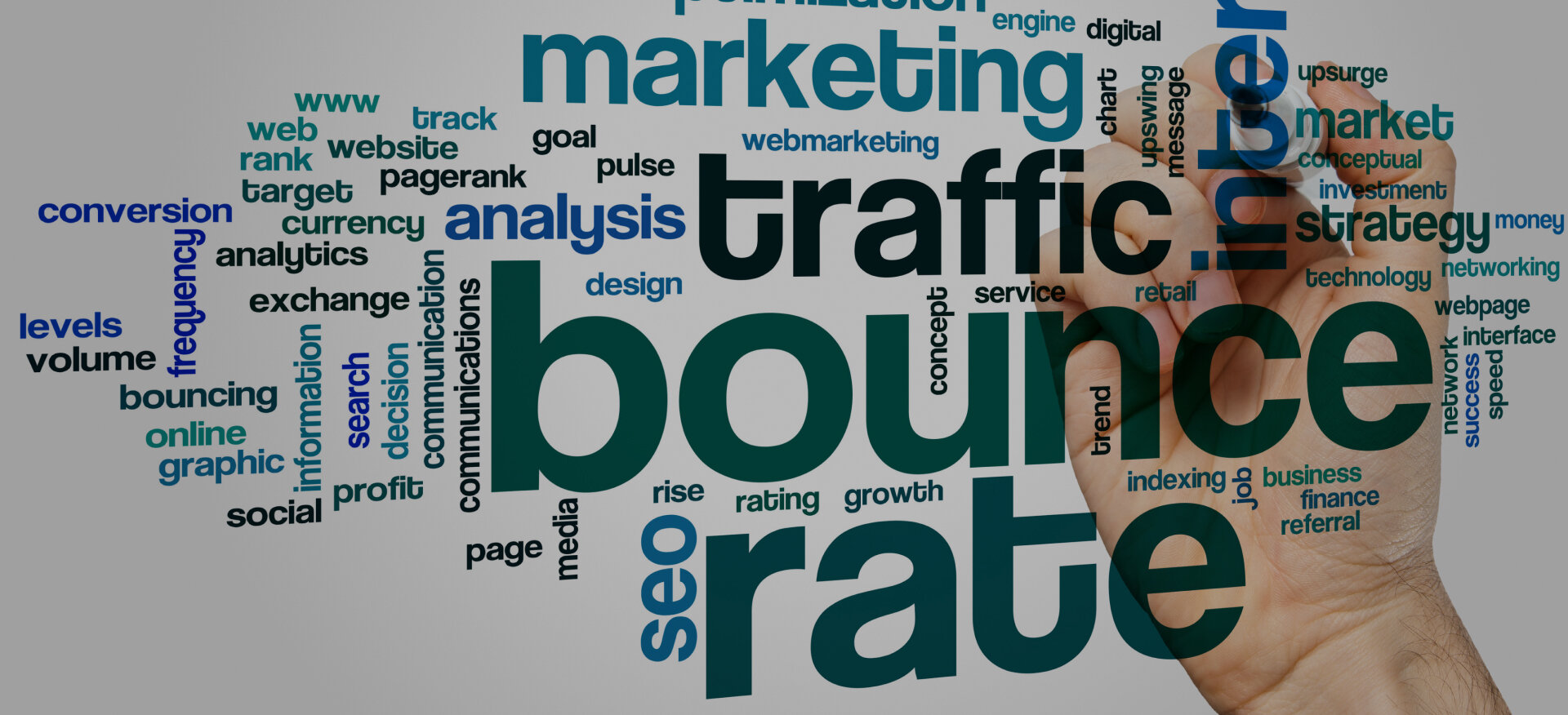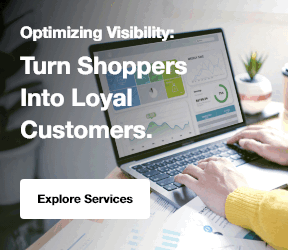Consumers are constantly bombarded with ads, pop-ups, cold emails, and unsolicited sales messages most of which are ignored or blocked.
As attention spans shrink and resistance to interruption grows, traditional outbound marketing methods are losing their impact. Inbound marketing offers a more thoughtful, value-driven approach.
Inbound marketing is a customer-centric strategy that attracts, engages, and delights potential buyers through useful content and meaningful interactions. Instead of pushing products or services, it pulls people in by offering solutions to their real problems and needs.
It’s a long-term strategy focused on quality engagement rather than quantity.
Thus, by aligning your marketing efforts with what people are actually searching for, inbound marketing transforms your brand into a magnet drawing the right audience, at the right time, with the right message.
Book Your Free Expert Consultation Now!
What is Inbound Marketing?
Inbound marketing is a customer-centric strategy designed to attract potential buyers by offering helpful, relevant, and informative content rather than interrupting them with ads or cold outreach.
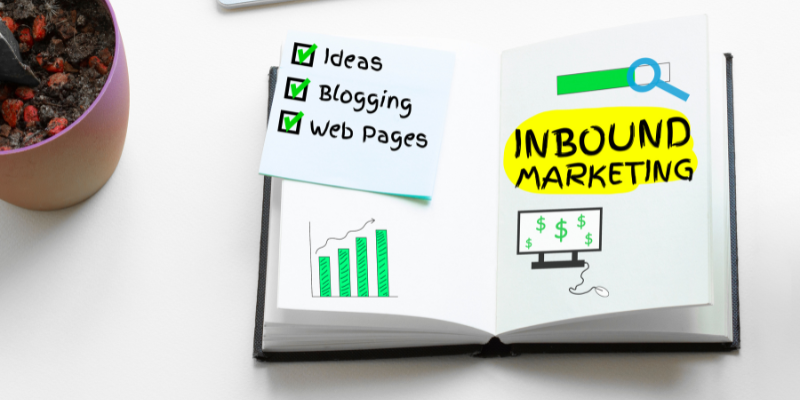
By using valuable strategies such as SEO ranking report tools, inbound marketers can track their content’s performance and refine their strategies for optimal results.
Unlike traditional marketing, which often involves pushing products or services onto audiences, inbound marketing pulls people in naturally by aligning with their needs and interests. For example, understanding how to get into digital marketing and applying those principles can help brands craft content that resonates with their audience.
Key features of inbound marketing:
- Attracts customers organically through valuable content that addresses their questions and pain points.
- Builds trust and credibility by focusing on education rather than hard selling.
- Guides leads through a natural buying journey using relevant content at each stage of the funnel.
- Focuses on earning attention, not buying it, through quality interactions and experiences.
Common channels and formats:
- Blog posts
- Social media updates
- Infographics
- Podcasts
- SEO-optimized landing pages
Through these content formats, inbound marketing creates multiple touchpoints that nurture leads, educate them, and help convert them into loyal customers over time.
5 Benefits of Inbound Marketing
Inbound marketing offers a range of long-term benefits that make it a smart investment for businesses of all sizes, particularly with its benefits of SEO. By optimizing content for search engines, businesses attract organic traffic, improving both visibility and engagement over time.
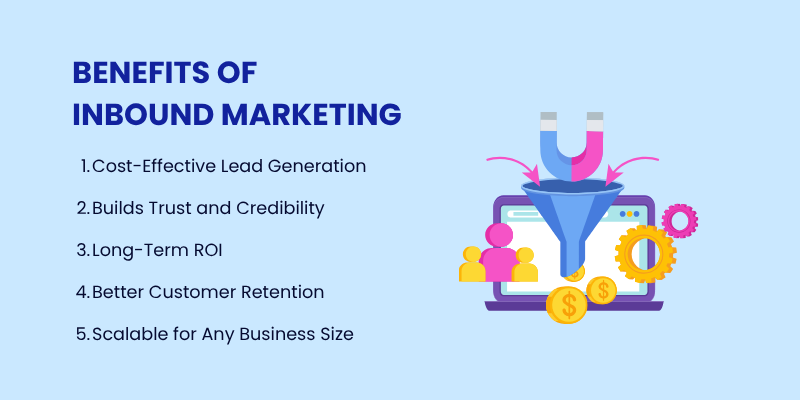
The key benefits of inbound marketing are:
- Cost-Effective Lead Generation: Inbound marketing is budget-friendly, as content like blogs and videos continues to attract traffic and leads over time, minimizing ongoing costs.
- Builds Trust and Credibility: By consistently providing valuable content, inbound positions your brand as an expert, fostering trust and leading to higher engagement and conversions.
- Long-Term ROI: Unlike paid ads, inbound content delivers lasting results, with evergreen posts, SEO, and email campaigns driving ongoing returns.
- Better Customer Retention: Inbound keeps customers engaged post-sale through personalized content and support, increasing loyalty and encouraging referrals.
- Scalable for Any Business Size: Inbound strategies can scale from small teams to large enterprises, offering flexibility in content creation and automation tools.
4 Core Stages of Inbound Marketing
Inbound marketing operates through a structured process that guides potential customers from initial interest to loyal advocacy.
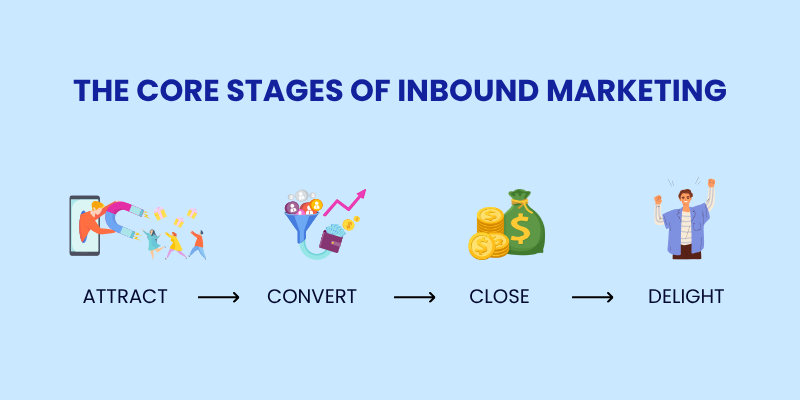
This process aligns well with what is the digital marketing strategy that tracks users across the web?, which enables businesses to monitor and adjust their marketing tactics based on user behavior and engagement.
It is often represented either as a flywheel (emphasizing momentum and customer satisfaction) or a 4-stage funnel (focusing on the buyer’s journey).
Here are the core stages of inbound marketing:
1. Attract
The first stage focuses on drawing the right audience, those already seeking information or solutions related to your offerings.
Through strategies like SEO, content marketing (blog posts, videos, infographics), and social media, inbound marketing aims to attract qualified visitors who are most likely to engage with your brand.
2. Convert
Once visitors arrive, the goal is to convert them into leads by capturing their contact information. Marketers offer valuable content like eBooks, webinars, or templates in exchange for details such as email addresses.
his is done through lead magnets, which are promoted on landing pages with clear calls-to-action (CTAs) to build a deeper relationship.
3. Close
At this stage, leads are nurtured into customers through targeted communication. Using CRM systems and email workflows, marketers track lead behavior and engage them with personalized content.
Lead scoring helps prioritize prospects, ensuring sales teams focus on the most qualified leads who are ready to purchase.
4. Delight
In the final stage, the focus shifts to customer satisfaction and loyalty.
By offering personalized content, soliciting feedback, and maintaining strong customer service, businesses can turn satisfied customers into brand advocates who refer new customers and share positive experiences.
Explore Our Digital Marketing Services!
Inbound Marketing vs. Outbound Marketing
Inbound and outbound marketing are two fundamentally different approaches to reaching and engaging potential customers.
While outbound marketing often uses Google Ads cost as a key metric, inbound marketing focuses on long-term value through quality content and organic engagement.
Outbound Marketing: This traditional approach pushes messages to a broad audience, regardless of their interest. Common tactics include cold calling, TV/radio ads, billboards, direct mail, and unsolicited emails. It's interruptive and focuses on capturing attention quickly.
Inbound Marketing:It focuses on earning attention through blog posts, SEO, educational videos, eBooks, and opt-in email newsletters, fostering a more engaged and interested audience.
Here’s a side-by-side comparison to highlight the key differences
|
Feature |
Inbound Marketing |
Outbound Marketing |
|
Approach |
Pull (attracts with value) |
Push (interrupts with promotion) |
|
Mediums Used |
Blogs, SEO, social media, email opt-ins |
Cold calls, print ads, TV/radio, pop-ups |
|
Audience Targeting |
Specific and interest-based |
Broad and general |
|
Communication Style |
Two-way, engaging |
One-way, promotional |
|
Cost Efficiency |
More cost-effective over time |
Can be expensive and short-lived |
|
User Permission |
Based on consent (opt-in) |
Often unsolicited (opt-out) |
|
Goal |
Build trust and relationships |
Drive quick awareness or sales |
8 Key Inbound Marketing Channels
Inbound marketing relies on various channels to attract, engage, and nurture potential customers. For instance, how does Shopify work can be integrated into an inbound strategy by leveraging its eCommerce platform to seamlessly connect content and product offerings, driving both engagement and conversions.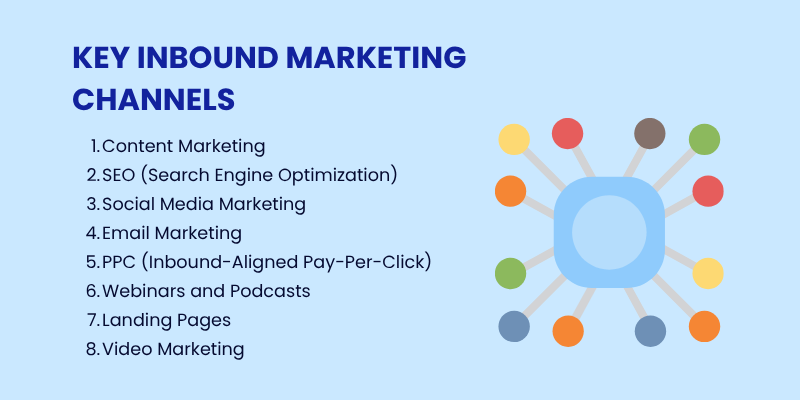 Each channel serves a specific purpose in reaching and interacting with the target audience.
Each channel serves a specific purpose in reaching and interacting with the target audience.
Here are some of the most effective inbound marketing channels:
1. Content Marketing
Content is the foundation of inbound marketing. It involves creating and sharing valuable, informative, and engaging content tailored to your audience’s needs and interests.
This includes:
- Blog posts that answer common questions or address pain points
- eBooks and guides that dive deeper into a topic
- Videos such as tutorials, explainer videos, or case studies
By addressing the audience’s needs and providing solutions, content marketing helps build trust, establish authority, and improve SEO rankings.
For instance, using LinkedIn Marketing to distribute thought leadership articles can enhance your brand’s reach within specific industries.
Explore Our Content Marketing Services!
2. SEO (Search Engine Optimization)
SEO is the practice of optimizing web pages to rank higher in search engine results. It includes:
- On-page SEO: optimizing keywords, headers, internal links, and metadata within content
- Off-page SEO: building high-quality backlinks and increasing domain authority
A strong SEO services strategy ensures that your content appears when potential customers search for topics relevant to your business, driving organic traffic to your website.
3. Social Media Marketing
Social media platforms are powerful tools to distribute your content, interact with followers, and build community.
The strategy should be platform-specific:
- LinkedIn for B2B thought leadership
- Instagram for visual storytelling
- Twitter for quick updates and engagement
- YouTube for educational and product-related videos
Social media humanizes your brand and allows for real-time engagement with your audience. A Digital Marketing Strategy often leverages these platforms to maximize brand visibility and engagement.
4. Email Marketing
Email is a key channel for nurturing leads and maintaining relationships.Inbound email marketing focuses on:
- Segmentation to send targeted content based on interests or behavior
- Drip campaigns that automate delivery of relevant messages over time
Email marketing helps nurture relationships with prospects, keep existing customers informed, and drive conversions through well-crafted campaigns and automated workflows.
Explore Our Email Marketing Services!
5. PPC (Inbound-Aligned Pay-Per-Click)
While PPC is often considered outbound, it can align with inbound principles when used strategically.
For example:
- Google Ads targeting keywords like “best CRM for small business”
- Sponsored content that leads to valuable gated resources
These ads meet users at the point of search intent and guide them into your inbound funnel. By leveraging performance marketing strategies, you can refine targeting and enhance the efficiency of these paid campaigns.
Explore Our Performance Marketing Services!
6. Webinars and Podcasts
Webinars and podcasts are excellent for educating your audience while building authority in your industry.
Webinars allow for live, interactive sessions where businesses can present valuable insights, answer questions, and engage with potential customers in real-time.
Podcasts offer a convenient way to share knowledge and reach an audience that prefers audio content, helping build a loyal following over time.
7. Landing Pages
Landing pages are specifically designed web pages created for a single marketing campaign or lead generation purpose.
They usually include compelling calls-to-action (CTAs) to drive visitors toward a specific action, such as downloading an eBook or signing up for a newsletter.
Well-designed landing pages are key to converting website visitors into leads. For businesses in sectors like oil and gas marketing agency, optimized landing pages can increase lead generation and conversion rates.
8. Video Marketing
Videos are one of the most engaging types of content and can be used across multiple platforms, such as YouTube, social media, or your website.
From product demos to how-to guides, explainer videos, and customer testimonials, video content helps communicate messages clearly and can significantly boost conversions.
It’s a powerful tool for showcasing your brand's personality and value propositions.
Inbound Marketing Tools & Technologies
To successfully execute an inbound marketing strategy, businesses rely on a suite of tools that streamline processes, enhance visibility, and improve lead nurturing.
For example, businesses can use SEO audit pricing tools to evaluate and optimize their content's performance, ensuring they get the most out of their investment.
These technologies support content creation, distribution, tracking, and automation ensuring your marketing efforts are efficient and data-driven.
1. Marketing Automation Platforms
Tools like HubSpot, Mailchimp, and ActiveCampaign are at the heart of many inbound campaigns. They allow you to:
- Create and manage email workflows
- Segment audiences
- Track user behavior
- Score leads automatically
HubSpot, in particular, offers an all-in-one platform that combines content management, CRM, email marketing, and analytics under one dashboard.
2. Analytics & SEO Tools
Understanding what works (and what doesn’t) is key to refining your strategy. Tools like Google Analytics provide deep insights into user behavior, traffic sources, and conversion paths.
Meanwhile, platforms like SEMrush and Ahrefs are vital for:
- Keyword research
- Competitor analysis
- Backlink tracking
- On-page and technical SEO audits
These tools help ensure your content is optimized for search engines and aligned with what your audience is actively looking for.
3. CMS Platforms
A robust Content Management System (CMS) is essential for publishing and managing inbound content. Popular platforms like WordPress and Webflow allow marketers to:
Easily create SEO-friendly blog posts and landing pages
Customize layouts without heavy coding
Integrate with email, CRM, and analytics tools
4. Engagement & CRM Tools
Chatbots (e.g., Drift or Intercom) engage visitors in real time, answer questions, and even qualify leads. Paired with Customer Relationship Management (CRM) systems, they help deliver personalized experiences based on user data.
Automation tools ensure that every touchpoint from the first website visit to post-sale engagement is relevant, timely, and optimized for conversion.
Challenges in Inbound Marketing
While inbound marketing offers powerful long-term benefits, it also comes with its share of challenges especially for businesses new to the strategy or lacking dedicated resources. For instance, SEO competition can be tough, and understanding organic SEO services requires a solid strategy to achieve long-lasting results.
- Time-Consuming to See Results: Inbound marketing takes time to show results, as SEO rankings and content authority require patience, making short-term success hard to prove.
- Requires Consistent Content Production: Regularly creating fresh, high-quality content is essential for maintaining traffic and engagement. Inconsistency can lead to losing audience attention.
- High SEO Competition: Standing out in search results requires technical SEO, keyword research, and link-building, which can be resource-intensive.
- Complexity in Analytics and Tracking: Measuring success involves tracking multiple metrics across platforms. Without the right tools, it’s difficult to connect data and demonstrate ROI effectively.
How to Get Started With Inbound Marketing?
While it doesn't require a huge budget, it does demand consistency, planning, and a commitment to providing value to your target audience.
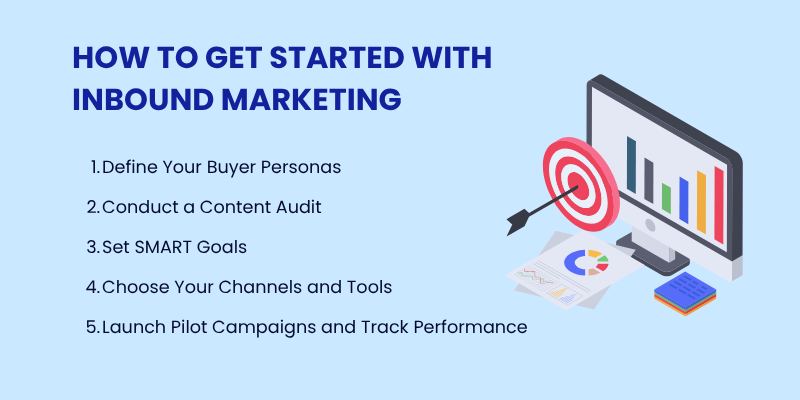
Here are the five steps to help you launch your inbound marketing journey:
1. Define Your Buyer Personas
To start, you need to identify and understand your ideal customers.
Buyer personas are detailed, semi-fictional representations of your target audience based on data and research. These personas include demographics, goals, pain points, behaviors, and more. By understanding what is B2C sales, you'll gain insights into consumer behaviors and how they make purchase decisions, helping you define your personas more effectively.
2. Conduct a Content Audit
Before creating new content, review what you already have. Analyze your existing blogs, videos, emails, and social media posts to see what’s working and what’s missing.
Ask questions like:
- Are you addressing your audience’s common pain points?
- Do you have content for all stages of the buyer’s journey, from awareness to decision?
This audit helps you understand the gaps in your current content strategy and provides direction for creating new, relevant content that will engage your audience.
For instance, you might want to use the noindex tag on older content that no longer serves your marketing goals, ensuring search engines don’t prioritize it.
3. Set SMART Goals
Your inbound marketing efforts need clear and measurable goals. SMART goals; Specific, Measurable, Achievable, Relevant, and Time-bound, help you track progress and stay focused.
Instead of vague objectives like “Get more traffic,” set specific targets such as “Generate 300 qualified leads in 3 months.”
Setting clear goals helps you measure success and adjust your strategy as needed, ensuring your efforts stay aligned with your overall business objectives.
4. Choose Your Channels and Tools
Choosing the right channels and tools is crucial to implementing a successful inbound marketing strategy.
Depending on your audience and content type, decide whether SEO, email marketing, social media, or other channels best suit your goals.
Tools like HubSpot, WordPress, Google Analytics, and social media schedulers can help you manage campaigns, track performance, and optimize your efforts.
How to search for words on a page effectively is important when using analytics tools to identify the most searched keywords on your content, helping you optimize for better engagement.
Select tools that fit your needs, budget, and team capabilities to streamline your processes and improve efficiency.
5. Launch Pilot Campaigns and Track Performance
Start with small, manageable campaigns to test your strategy before going big.
For example, you can create an eBook or host a webinar, then promote it through the chosen channels to see how your audience responds. Monitor key metrics like engagement, conversion rates, and traffic to refine your approach.
Use the data you collect to make informed adjustments and scale successful tactics.
Following these steps ensures a focused, strategic approach to inbound marketing.
Conclusion & Final Thoughts
Inbound marketing is more than just a marketing strategy it’s a philosophy centered on providing value, building trust, and fostering meaningful relationships with your audience.
With the right strategy, businesses can track Google keyword ranking and optimize their content to meet the evolving needs of their audience.
Rather than interrupting potential customers with sales-driven messages, it invites them into your world through helpful content, personalized experiences, and genuine engagement.
By focusing on your audience’s needs and offering solutions instead of hard sells, you not only attract the right visitors but also nurture them into loyal advocates.
From startups to large enterprises, inbound marketing offers scalable, cost-effective results that grow over time. Now is the perfect time to align your brand with what your audience truly wants: support, insight, and trust.




